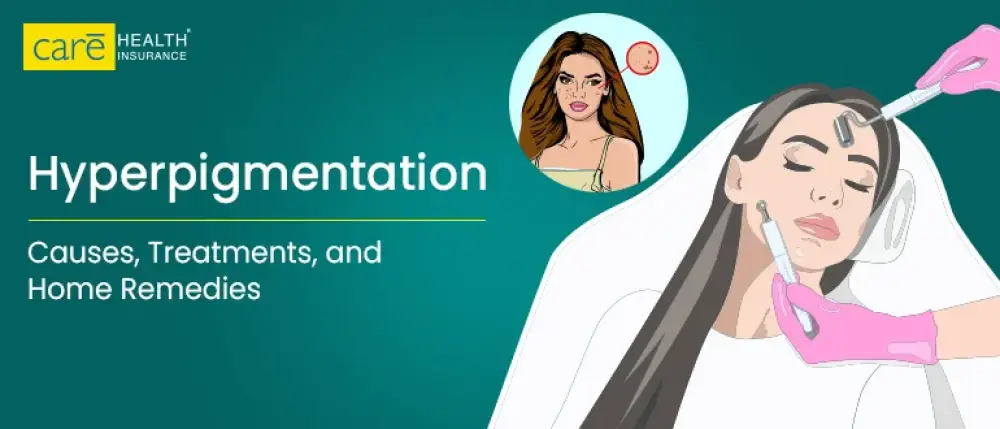Subscribe to get weekly insights
Always stay up to date with our newest articles sent direct to your inbox
Published on 26 Jun, 2025
Updated on 26 Jun, 2025
202 Views
5 min Read

Written by Mudit Handa
Reviewed by Akhil Pillai
favorite0Like
favoriteBe the First to Like
In India, people are frequently exposed to direct sunlight and are accustomed to warm climates, especially in the plains. The consistent exposure leads to certain skin conditions that affect a person's appearance. One such common skin condition is hyperpigmentation.
A considerable percentage of Indian women experience hyperpigmentation, with common forms including melasma and post-inflammatory hyperpigmentation (PIH).
This article will guide you through understanding hyperpigmentation's root causes and effective treatment methods.
Hyperpigmentation is a common skin condition characterised by patches of skin becoming darker than the surrounding areas. This darkening is caused by increased melanin production. It can affect people of all skin types.
Melanin is the pigment responsible for skin colour. It is produced by melanocytes, specialised cells located in the epidermis, the outermost layer of skin. When these melanocytes produce excess melanin, it accumulates in the skin, developing hyperpigmented spots or patches and darkening specific areas of skin.
No. This condition is not limited to any specific race or ethnicity; it can affect individuals of all skin types, ranging from fair to dark complexions. Hyperpigmentation can vary greatly, appearing as small, isolated spots or large, widespread areas of discolouration. It can occur on various body parts, including the face, hands, neck, and chest, which are frequently exposed to sunlight.
No, hyperpigmentation is not a genetic disease. It occurs due to overexposure to sunlight and several other medical conditions. While often a cosmetic concern, hyperpigmentation is typically harmless and not indicative of an underlying medical issue. However, in rare cases, it can be a symptom of other health conditions, necessitating consultation with a dermatologist for diagnosis and treatment.
As it affects an individual’s overall appearance, it may impact their self-esteem and overall persona. Fortunately, there are various ways to treat or mitigate this skin condition. Let us first understand the root causes of hyperpigmentation.
Several key factors can trigger hyperpigmentation. Let’s try to understand the root causes of hyperpigmentation:
These are some medical conditions that can cause hyperpigmentation. Such situations require proper diagnosis and immediate management of the cause.
Depending on the cause and severity, removing hyperpigmentation can be challenging. It is usually impossible to completely remove the signs of this skin condition.
However, with the right approach, significantly improving the skin condition affected by hyperpigmentation is often achievable. Several advanced methods have been successful in mitigating the signs of hyperpigmentation.
Several hyperpigmentation treatment options are available, and the best approach depends on the type and cause of hyperpigmentation.
These are some highly effective methods of hyperpigmentation treatment. However, you must consult a dermatologist before undergoing any of the above treatments.
Hyperpigmentation can sometimes be addressed with home remedies, though results vary.
Here are some potential home remedies to treat skin pigmentation:
Key Take: It's crucial to note these are not substitutes for professional medical advice. Always do a patch test before applying any new substance to your face. If you have sensitive skin, you must consult a dermatologist first.
These are some practical ways to treat hyperpigmentation. Indeed, a healthy lifestyle and proper skincare can prevent all kinds of skin problems.
Apart from a healthy lifestyle, stress management is essential for healthy skin. To live a stress-free life, you need comprehensive health coverage to manage your medical emergency costs.
>>Read More: A Guide to Ozone Therapy: Benefits, Risks & Cost
Undergoing an advanced skin treatment is sometimes essential to treat severe conditions. Specialised treatment can be quite expensive. And treatments like ozone therapy are priced based on the number of sessions needed.
Therefore, having a thorough health insurance plan that adequately covers advanced medical treatments up to the insured amount is essential. When selecting comprehensive health coverage, it's important to consider key factors such as sub-limits, co-payments, and waiting periods for any pre-existing conditions.
Disclaimer: Plan features, benefits, coverage, and claims underwriting are subject to policy terms and conditions. Kindly refer to the brochure, sales prospectus, and policy documents carefully.
favoriteBe the First to Like
Thyroid : मामूली नहीं हैं महिलाओं में थायराइड होना, जानें इसके लक्षण और घरेलू उपचार Vipul Tiwary in Diseases
शुगर कंट्रोल कैसे करे? जानें, डायबिटीज में क्या खाना चाहिए Vipul Tiwary in Health & Wellness
हाई ब्लड प्रेशर को तुरंत कंट्रोल कैसे करें? देखें इसके उपाय Vipul Tiwary in Diseases
पैरों में दर्द किस कमी से होता है? जानें, इसके घरेलू इलाज Vipul Tiwary in Health Insurance Articles
When Silent Clots Threaten Your Life: DVT Pratham Gupta in Diseases
What are Dandruff Symptoms and Their Causes? Pratham Gupta in Diseases
What is Atherosclerosis, its Symptoms, and Treatment? Bhawika Khushlani in Diseases
What Is a Hysterectomy? A Complete Guide For Women’s Health Pratham Gupta in Diseases
Always stay up to date with our newest articles sent direct to your inbox
Loading...